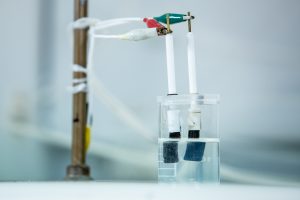Scientists at RMIT have made a breakthrough by developing a cheaper and more energy-efficient way to make hydrogen directly from seawater, without needing to desalinate the water.
Hydrogen has long been touted as a sustainable alternative fuel and a potential solution to critical energy challenges, particularly for industries that are more difficult to transition to low-carbon sources like manufacturing, aviation, and shipping.
Almost all of the world’s hydrogen currently comes from fossil fuels. Its production is responsible for around 830 million tonnes of carbon dioxide a year, equivalent to the annual emissions of the United Kingdom and Indonesia combined.
But emissions-free ‘green’ hydrogen, made by splitting water, is so expensive that it is not viable commercially and accounts for just 1% of total global hydrogen production.
A new approach, invented by a multidisciplinary Materials for Clean Energy and Environment (MC2E) research group at RMIT, uses a unique catalyst specifically designed to function with seawater.
Lead researcher Dr Nasir Mahmood, a Vice-Chancellor’s Senior Research Fellow at RMIT, said the existing process of splitting water has these difficulties:
- Expensive catalyst and has huge water and energy consumption.
- You can only use fresh or desalinated water (without its impurities as found in seawater).
- It generates toxic byproducts such as chlorine which is much higher than the amount of hydrogen produced and used.
- It’s not sustainable as it uses a lot of energy and essentially means the use of fossil fuel to make that energy
So a new method from RMIT University researchers is a critical step toward a truly viable green hydrogen industry. It uses an electrolyser to split the seawater directly into hydrogen and oxygen – skipping the need for desalination and its associated cost, energy consumption, and carbon emissions.
But is also solves one of the biggest challenges up until now from using seawater to make hydrogen – excess chlorine production.
“Our process not only omits carbon dioxide but also has no chlorine production,” Dr Mahmood said.
“The biggest hurdle with using seawater is the chlorine, which can be produced as a by-product. If we were to meet the world’s hydrogen needs without solving this issue first, we’d produce 240 million tons per year of chlorine each year – which is three to four times what the world needs.
“There’s no point replacing hydrogen made by fossil fuels with hydrogen production that could be damaging our environment in a different way. Our method to produce hydrogen straight from seawater is simple, scaleable, and far more cost-effective than any green hydrogen approach currently in the market.”

The RMIT electrolysis experiments
A provisional patent application has been filed for the RMIT process.
PhD candidate Suraj Loomba said their focus was on producing highly efficient, stable catalysts that can be manufactured cost-effectively.
“Our approach focused on changing the internal chemistry of the catalysts through a simple method, which makes them relatively easy to produce at large scale so they can be readily synthesised at industrial scales,” he said.
Mahmood said the technology could bring down the cost of electrolysers – to meet the Australian Government’s goal for green hydrogen production of $2 a kilogram, to make it competitive with fossil fuel-sourced hydrogen.
The researchers at RMIT are working with industry partners to develop aspects of this technology.
The next stage in the research is the development of a prototype electrolyser that combines a series of catalysts to produce large quantities of hydrogen.
Credit: Source link


Comments are closed.